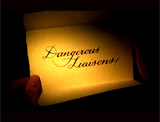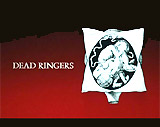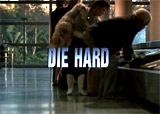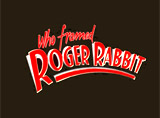
|
![]()
Greatest Films of the 1980s
1980 | 1981 | 1982 | 1983 | 1984 | 1985 | 1986 | 1987 | 1988 | 1989
Title Screen Film Genre(s), Title, Year, (Country), Length, Director, Description 

The Accidental Tourist (1988), 121 minutes, D: Lawrence Kasdan


The Accused (1988), 111 minutes, D: Jonathan Kaplan
This thoughtful, fact-based drama was based on a real-life incident of a 1983 rape in New Bedford, Massachusetts. It provided a provocative look at how the justice system treated victims who were often seen as worthy of blame. In mid-April 1987, Sarah Tobias (Jodie Foster in an Oscar-winning role), a sexily-dressed, drunk, working-class patron was in The Mill, a seedy roadside bar, following a fight with her live-in boyfriend Larry (Tom O'Brien) - he was a drug dealer and would-be musician. A bruised, still-intoxicated and half-dressed Sarah ran barefoot and screaming from the roadside bar where she'd just been raped by three men on a pinball machine. Prosecuting Deputy D.A. Kathryn Murphy (Kelly McGillis) took the case, and thought her only chances were a plea bargain with the brutal gang-rapists. She knew she couldn't get a conviction, because Sarah would be unfairly accused of enticing her attackers: "Raped? She f--ked a bar full of guys then she turns round and blames them for it?" The three rapists agreed to plea guilty to "reckless endangerment" instead of rape, with a lesser sentence of no more than 9 months in jail. They were Danny (Woody Brown), Bob Joiner (Steve Antin), and Kurt (Kim Kondrashoff). To satisfy Tobias who disagreed vehemently with her tactics and felt betrayed, Murphy further pursued the case by prosecuting three of the onlooking bystanders for "criminal solicitation" - for inciting or encouraging others to commit a crime. However, she was unsupported by DA Paul Rudolph (Carmen Argenziano). College-frat student Kenneth Joyce (Bernie Coulson) was the key witness who saw the rape (and had watched the encouraging bystanders), but was initially reluctant to testify. He then agreed since his testimony was the crux of the case. He had called 911, but did not personally intervene during the incident. The entire rape episode was voyeuristically envisioned during the lengthy witness recounting (on Sarah's behalf), describing how the three barflies cheered on the rapists. Murphy presented a forceful court argument against the men who encouraged the rape of her client: "These three men did worse than nothing. They cheered, and they clapped, and they rooted the others on. They made sure that Sarah Tobias was raped, and raped, and raped. Now you tell me, is that nothing?" The three who were convicted: Cliff 'Scorpion' Albrect (Leo Rossi), Matthew Haines (Andrew Kavadas), and Stu Holloway (Tom McBeath).

Akira (1988, Jp.), 124 minutes, D: Katsuhiro Otomo



Big (1988), 104 minutes, D: Penny Marshall



Bull Durham (1988), 108 minutes, D: Ron Shelton
First-time director Ron Shelton, a former second-baser in the minor leagues, has made a prominent career of sports movies that realistically examine the participants' heart, both in terms of sportsmanship and in terms of romance. His writing (and directing) credits have also included: The Best of Times (1986) (football), White Men Can't Jump (1992) (basketball, also directed), Blue Chips (1994) (basketball), Cobb (1994) (baseball, also directed), The Great White Hype (1996) (boxing), Tin Cup (1996) (golf, also directed), and Play It To the Bone (2000) (boxing, also directed). This humorous romantic drama about the North Carolina minor leagues is the quintessential modern sports film of America's greatest game. Kevin Costner stars as "Crash" Davis, a veteran, romantic-minded, minor league catcher who has to tutor wild young, rookie pitcher Ebby Calvin "Nuke" LaLoosh (Tim Robbins) for the mediocre Durham Bulls, while simultaneously competing with him - in a love triangle - for the affections of English teacher and sexually-seductive baseball groupie Annie Savoy (Susan Sarandon, Robbins' real-life 'wife'). Bull Durham would only receive a single Oscar nomination for Shelton's writing, while Costner's next film would be another baseball film, the mystical Field of Dreams (1989), based on the W.P. Kinsella book.


Cinema Paradiso (1988, It.) (aka Nuovo Cinema Paradiso), 123 minutes, D: Giuseppe Tornatore


A Cry in the Dark (1988, Australia/US) (aka Evil Angels), 120 minutes, D: Fred Schepisi
The central characters in this docu-drama (a true life story), living in Queensland, Australia, were 7th-Day Adventist Church minister Michael Chamberlain (Sam Neill), his devout and religious wife Lindy (Meryl Streep), and their three children, including 10-week old infant Azaria. In late summer of 1980, the family took a vacation camping trip to the aboriginal sacred spot Ayers Rock in the central Australian outback. During an outdoor nighttime barbecue with other campers, Linda claimed that she saw a dingo (wild dog) carrying off her sleeping baby from their open camping tent. She was frantic: "The dingo took my baby!" After a search, Azaria was never found. After an initial inquest, it was ruled that Lindy's dingo account was true. However, the explosive case caused a media frenzy and unfair witch-hunt, and some theorized that Lindy, who appeared cold-hearted, stoic and emotionless (at the request of her lawyer), had carried on a ritualistic sacrifice of her child by decapitating the baby with a pair of scissors. Michael was found with a small wooden coffin used as a "offering plate" for his parishioners' packs of un-smoked cigarettes, fueling speculation about a sacrifice. The press also published the inaccurate rumor that Azaria meant "sacrifice in the wilderness." When the police questioned Lindy more thoroughly, inconsistencies caused them to suspect her, and the case was reopened as a murder case. Her husband was charged with being an accessory. Ian Baker (Bruce Myles) was the case's prosecutor, while the couple (who testified in their own defense) were represented by Phillips (Neil Fitzpatrick). During the testimony in a second hearing, forensic experts (from London) and other academic experts provided lots of circumstantial evidence, but nothing conclusive. The infant's jumpsuit (with ripped gashes not caused by a dingo) was found in a cave about three miles from the campsite. There was conflicting and confusing evidence presented about the jumpsuit, and about the predatory behavior of dingos. For example, there were traces on infant blood in a camera case and in the family's car, but the causes were unclear. Professor Cameron (Kevin Miles) testified that there were small bloody imprints on the jumpsuit, and that the lack of saliva on the clothing indicated that it wasn't a dingo attack. He was countered by another expert who claimed saliva was present. In an obvious miscarriage of justice (there was no body, no motive, no weapon, and no hard evidence), in October of 1982, Lindy was found guilty of murder and sentenced to a life sentence - with hard labor. Michael was found guilty as an accessory and given an 18-month suspended sentence. Then over three years later, Azaria's outer jacket was found. Lindy was released from prison, and the case was reopened. In 1988, all convictions against Lindy and Michael were overturned.



Dangerous Liaisons (1988, US/UK), 120 minutes, D: Stephen Frears


Dead Ringers (1988), 115 minutes, D: David Cronenberg


Die Hard (1988), 132 minutes, D: John McTiernan
See Die Hard film series.


A Fish Called Wanda (1988), 108 minutes, D: Charles Crichton
One of the cleverest, quirkiest and wittiest madcap caper comedies ever made, that included members of the original anarchic Monty Python troupe with American stars - in a subversive and raucous tale that combined both British and American humor. The film recalls the British Ealing Studio comedies (such as Crichton's own The Lavender Hill Mob (1951) and The Ladykillers (1955)) and Preston Sturges' The Lady Eve (1941). As the tagline stated, the unexpected hit was "a tale of murder, lust, greed, revenge, and seafood," in which three eccentric thieves (Jamie Lee Curtis, Kevin Kline, and Michael Palin) battle the authorities and each other to recover a valuable cache of stolen diamonds. All actors are perfect in their roles, especially the self-absorbed, not-too-bright ("Don't you ever call me stupid") Buddha-misquoting Anglophobe Otto West (Kevin Kline) and the stuttering, animal-loving hitman Ken (Palin). Features such bits as Ken's attempts at murdering an old woman that results in the deaths of her dogs (to his horror), Otto's constant tormenting of Ken ("Look! It's K-k-ken coming to k-k-kill me!") and conservative, uptight barrister Archie Leach (John Cleese), Wanda Gerschwitz's (Jamie Lee Curtis) use of sex to dominate the men in her life and her total arousal to foreign languages like Italian and Russian. The leads would team up again in the comedy Fierce Creatures (1997), in lieu of a sequel.

Hairspray (1988), 94 minutes, D: John Waters



Heathers (1988), 102 minutes, D: Michael Lehmann




High Hopes (1988, UK), 110 minutes, D: Mike Leigh


The Last Temptation of Christ (1988), 164 minutes, D: Martin Scorsese
An adaptation of Nikos Kazantzakis' novel, presenting a more fallible human version of Jesus (Willem Dafoe) - a controversial yet provocative possibility.


Mississippi Burning (1988), 128 minutes, D: Alan Parker


My Neighbor Totoro (1988, Jp.) (aka Tonari no Totoro), 87 minutes, D: Hayao Miyazaki


Rain Man (1988), 134 minutes, D: Barry Levinson
This Best Picture-winning drama, a comedy road film, paired two actors who delivered superb character performances: Tom Cruise (as boastful yuppie California car dealer Charlie Babbitt) and Oscar-winning co-star Dustin Hoffman (as Raymond) - brothers unknown to each other, forgotten and separated at infancy. Institutionalized older sibling Raymond was awarded a $3 million inheritance in trust when their wealthy estranged father died. During a cross-country road trip and kidnapping from Cincinnati, Ohio to California (with an entertaining detour to Las Vegas), Raymond revealed his self-absorbed, anxious, autistic-idiot savant condition (with an amazing memory and facility with numbers), while the shallow, selfish, greedy and exasperated Charlie attempted to separate him from the lion's-share of the money. Hoffman personified Raymond perfectly (without caricaturing), using a stiff gait, cocked head, a reliance on routines, and endless chatter. Popular catchphrases have often been quoted from the dialogue, such as: "Kmart sucks," "I'm an excellent driver," and "Ten minutes to Wapner." The memorable car trip brought about self-discovery, values reassessment and reconciliation. Their relationship and bond intensified and grew touching as they developed a caring and connected understanding for each other, and Charlie's initial plan to wheel-and-deal his brother to give up the fortune had a change of heart. In their tear-jerking emotional farewell scene, the two brothers, now bonded, touched heads together.

The Thin Blue Line (1988), 101 minutes, D: Errol Morris
This engrossing documentary expose about a gross miscarriage of justice from writer/director film-maker Errol Morris had the intriguing tagline: "A softcore movie, Dr. Death, a chocolate milkshake, a nosey blonde and 'The Carol Burnett Show.' Solving this mystery is going to be murder." [Note: Morris' original intention was to make a documentary about notorious Dallas forensics psychiatrist James Grigson, who had earned the nickname 'Dr. Death' for the number of times his expert testimony had been instrumental in sending defendants to the electric chair.] The crime scene and investigation of a police officer's murder in Dallas, Texas in late November of 1976, was re-enacted in the film. The crime occurred during the Thanksgiving Day weekend in 1976, after 28 year-old drifter Randall Dale Adams (Himself and Adam Goldfine) ran out of gas on the highway. He hitched a ride with 16 year-old teenager David Ray Harris (Himself and Derek Horton) driving a stolen blue compact car (and also having stolen his father's .22 caliber revolver and shotgun). A few hours later (after drinking, smoking pot, and watching two soft-core porno films at a local drive-in), their car was routinely stopped (for not having proper lights) shortly after midnight by Dallas police officers Robert Wood (Ron Thornhill) and Teresa Turko (Marianne Leone). Wood was killed with five shots as he approached the car - it was unclear who had pulled the trigger. Turko (who had cast aside a chocolate milkshake) couldn't confirm conclusively the type of car or its driver. Police were alerted to Harris after he had returned to his small Texas hometown of Vidor, where he bragged about killing "the f--king pig." When police questioned him, he perjured himself and pinned the killing on Randall. About a month after the crime, Adams was arrested and questioned (without a lawyer present), all the while protesting his innocence. He was forced to sign a false confession that he was in the car with Harris, but didn't know what had happened. Assistant District Attorney Doug Mulder charged Adams with the murder, and pushed for the death penalty. Harris escaped with any charges because he was an underage juvenile and couldn't be sentenced to death. Adams was defended by defense attorneys Edith James (Herself) and Dennis White (Himself), while the judge presiding over the case was Donald J. Metcalfe (Himself). During the murder trial, Harris claimed it was Adams who (1) was driving, and (2) shot and killed the officer with the stolen gun under the seat. Harris said he was crouched down in the passenger seat. Other misleading eyewitnesses claimed that Adams was the killer, but Mulder was able to keep their testimony a secret so that they couldn't be cross-examined. Adams calmly contradicted Harris' account. He said he had been dropped off at his motel room at about 9:30 pm, a few hours before the crime, and that he had watched The Carol Burnett Show on TV before going to sleep. Nonetheless, Adams was convicted and sentenced to death in 1977, but his sentence was later commuted to life in prison. As a result of the film, convicted murderer Adams, who had been wrongly imprisoned for twelve years, was finally set free.



The Unbearable Lightness of Being (1988), 171 minutes, D: Philip Kaufman



The Vanishing (1988, Netherlands/Fr.) (aka Spoorloos), 107 minutes, D: George Sluizer



Who Framed Roger Rabbit (1988), 104 minutes, D: Robert Zemeckis
A technically-marvelous film blending animated, ink-and-paint cartoon characters and flesh-and-blood live actors, in a convincing comedy/mystery noir thriller, set in Los Angeles in 1947. Very loosely based on Gary Wolf's 1981 novel Who Censored Roger Rabbit? (with comic-book and newspaper strip characters who speak with word balloons instead of voices) -- in a very sanitized version. The film is a delightful spoof of the hard-boiled Sam Spade films and reminiscent of Chinatown (1974), complete with a sultry, femme fatale humanoid Toon named Jessica Rabbit (Kathleen Turner, uncredited, with singing voice by Amy Irving, Amblin Entertainment executive producer Steven Spielberg's wife at the time), and a case involving alleged marital infidelity ("pattycake"), murder, a missing will, blackmail, and a conspiracy hatched by evil, Toon-hating Judge Doom (Christopher Lloyd) (of Cloverleaf Industries). Doom's plan is to bring freeways to LA, thereby ruining the existing Pacific & Electric Red Car public transport electric trolley system. The film revolves around the murder of Marvin Acme (Stubby Kaye), a gag-gift promoter and props supplier (Acme Novelty Co.) for all Toon productions and the owner of the ghetto-ized Toon-town where the Toons, regarded as a segregated minority group, live just outside Hollywood. Framed for the murder, zany Maroon Cartoon Studios actor Roger Rabbit (Charles Fleischer), a stuttering, disaster-prone 'Toon,' solicits help from reluctant, hard-boiled, boozing private eye Eddie Valiant (Bob Hoskins) to clear his name. Valiant is still grief-stricken over the death of brother Ted by a falling cartoon piano, but is financially - and emotionally - supported by girlfriend Dolores (Joanna Cassidy), as he solves the case. Earlier efforts to combine humans and ink-and-paint cartoon characters side-by-side in a film (Disney's Song of the South (1946) and Mary Poppins (1964), for example) are considered primitive next to this film, which used computers to precisely repeat camera movements and calculate shading, to allow them to cast shadows and have complex lighting. Unprecedented cooperation from Warner Brothers and Disney allowed for classic cartoon characters to be seen together for the first time, such as Mickey Mouse and Bugs Bunny parachuting together, having both Tinkerbell and Porky Pig end the movie, and, of course, the famous piano duel between Daffy and Donald Duck in a Cotton Club-style nightclub, the Ink & Paint Club.


Women on the Verge of a Nervous Breakdown (1988, Sp.) (Mujeres al Borde de un Ataque de 'Nervios'), 90 minutes, D: Pedro Almodóvar



Working Girl (1988), 113 minutes, D: Mike Nichols